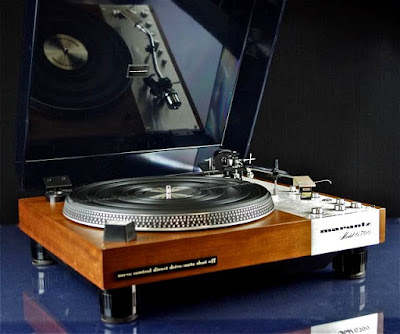The turntable unit.
All turntables works more or less the same way. They
consist of a plate that rotates the disk,and a pickup arm with a capsule
that receives instructions from disk and converts them into electrical signals.
The plate.
The turntable is to circulate and rotates to a
pre-established velocity moved by an electric motor. For disks of L.P (Long Play) and for some
maxisingles of 7 inches, has to rotate to 33⅓ r.p.m (revolutions per minute). For the
majority of the disks of 7 inches goes something more fast, 45 r.p.m.The motor system is it more important of the
turntable. Unless function silently and without no variation of velocity, the
sound will not be seen affected. A noisy
motor, for example, will produce an bother murmur ("rumble"). In certain models of turntable, an electric
motor of high velocity prompts the platform by means of a band of rubber and
the corresponding pulleys. More recently
has been introduced the plates of transmission direct, in which the axis of the
motor connects directly with the plate.
The tone arm.
The function of the tone arm is held in position while
the needle is offset by the disc. At the same time it must apply a tangential
force correct.This force depends on the type and quality of the arm.It can be
adjusted with a counterweight situated in an extreme of the arm.The arm also
has been designed to minimize the "slant" or natural tendency to move
toward the center of the disc.
The pickups are usually supported arms at one point and
they have form of "S" or "J".This type has a degree of
"path error" because the record does not disclose on a straight path,
as did head to burn the disc. At the present this turntables are available with
arms straight route describing a straight line on the disk.
The cartridge.
The first gramophone and plates turntables were equipped
with cartridge of crystal or ceramics.They have been substituted for mobile types of magnet, magnet-induced/
mobile iron and coil mobile. All these
generators of sign depend on the relative movement among a magnet and a length
of coil. The mobile type of magnet has a
pair of coils fixed. A small magnet
mounted in the extreme of the needle is moved responding to the vibrations of
the same one and creates in the coils a current fluctuating.In the type of coil mobile, the magnet is
fixed and the coils are placed in the extreme of the needle.
The needle.
The needle,is united to the phono head or capsule. It has the tip of sapphire or diamond and
form hemispheric, although at present the elliptic form (biradial) is doing
popular. The width of the tip impedes it
to touch the fund of the furrow in the disk, but maintains it in contact with
the walls.
1) Sony stereo turntable PS-4750. 1974.
2) Sony stereo turntable PS-X6. 1977.
 | |
| Interior view of the plate and velocity reference signal plate´s sensor Sony turntable PS-4750. |
2) Sony stereo turntable PS-X6. 1977.
 | |
| View motor Sony stereo turntable PS-X6. |
 | |
| Drawing mechanism of the tone-arm Sony stereo turntable PS-X6 |
 |
| View phono magnetic cartridge (XL-15) Sony stereo turntable PS-X6. |
 |
| View of the motor serve mechanism and sensor. |
 |
| Phono magnetic cartridge stereo turntable Aurex Toshiba SR-510E. |
 |
| Drawing magnetic cartridge Aurex Toshiba SR-510E. |
Trio-Kenwood KP-7300 stereo turntable. 1976.
 |
| Cross-sectional drawing Trio-Kenwood KP-7300. |
 |
| View and drawing of the tone-arm Trio-Kenwood KP-7300. |
Onkyo stereo turntable PX-5F. 1980.
 |
| Drawing Onkyo turntable PX-5F. |
 |
| View and description tone-arm. |
2) Victor-JVC stereo turntable QL-5R. 1977.
 |
| Interior of the motor stereo turntable Victor-JVC QL-5R. |
 |
| View phono magnetic cartridge stereo turntable Victor-JVC QL-5R. |
1) Technics stereo turntable SL-1600. 1977.
2)Technics stereo turntable SL-1200 MKII. 1979.
1) Yamaha stereo turntable YP-D10. 1978.
 |
| The outstanding audio engineering Yamaha. View of the counterweight and adjustments of the mechanism. |
2)Yamaha stereo turntable PF-1000. 1983.
1)Sansui stereo turntable SR-838. 1978.
 |
| Sansui´s quality engineering. |
2)Sansui stereo turntable SR-222 MKII. 1979.
 |
| View of the counterweight. |
 |
| View tone-arm Pioneer turntable PL-5L. |
2) Pioneer stereo turntable XL-A700. 1977.
 |
| Motor internal part Pioneer XL-A700. |
3) Pioneer stereo turntable PL-1250. 1975.
Stereo turntable Lo-D Hitachi HT-550H. 1978.
Stereo turntable Luxman PD-289. 1984.
Thorens stereo turntable TD 127 Electronic with SME 3012 Series II. 1983.
Marantz stereo turntable model 6300. 1975.














































0 comentarios:
Post a Comment